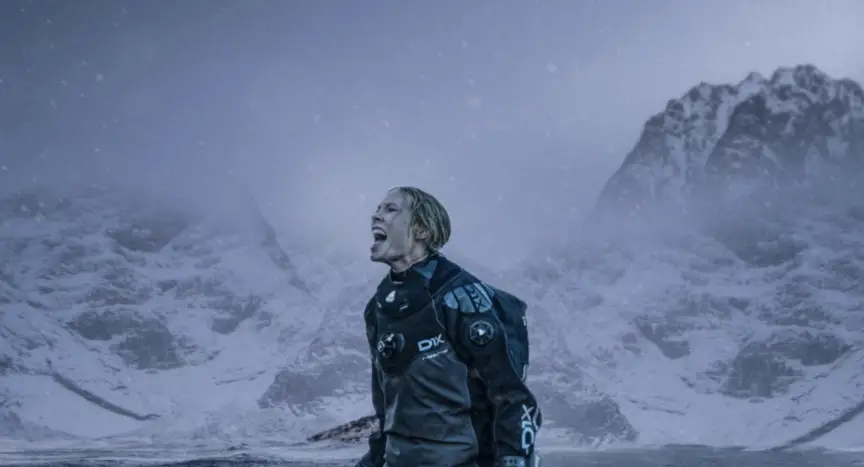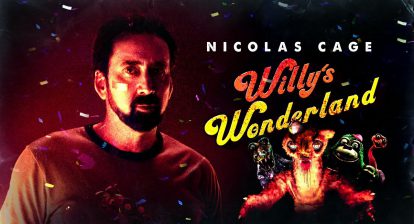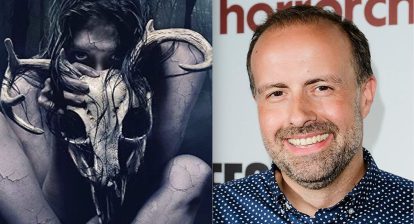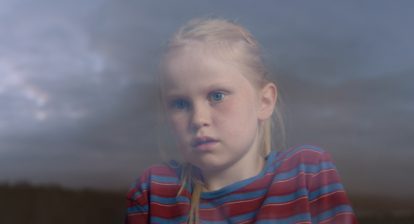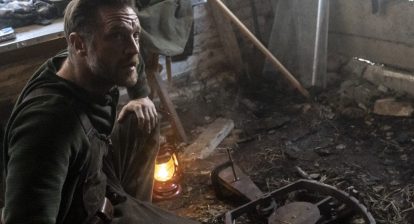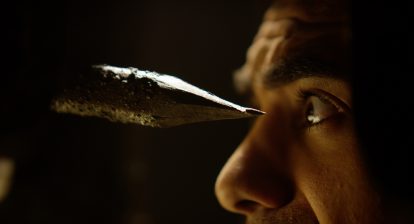It’s safe to say that the horror genre is one of the most complex of the film genres, especially with the many different subgenres it’s comprised of. Some of those subgenres include; slasher, psychological, found footage and paranormal to name a few. Another horror subgenre that we tend to see less of is that of aquatic horror/thrillers. Deep Blue Sea, Sphere, Deep Rising and more recently, Underwater starring Kristen Stewart are a few that come to mind. Another film is this subgenre, that is currently making waves is Doppelgänger Releasing’s Breaking Surface.
In case you haven’t heard of the film, the synopsis reads: A few days after Christmas, half-sisters Ida and Tuva set out on a winter dive in a remote part of the Norwegian coastline. Towards the end of the dive, a rockslide traps Tuva under water. As Ida surfaces to call for help, she discovers that the rockslide has struck above water as well, burying their equipment, phones and car keys–they are completely cut off from any chance of outside rescue. As the frantic race for survival unfolds, Ida is put to the ultimate test of character and forcefulness. During Ida’s fight to save Tuva, a fractured sisterhood is exposed, and when all seems lost, the stakes rise beyond simple survival.
Adding another layer to the thrill ride is the score by composer Patrick Kirst. Patrick’s previous work can be heard on Netflix’s The Kissing Booth, a lot different type of project. Not to sound cliché, but Patrick’s Breaking Surface score hits all the right notes. It raises the intensity when needed and also adds a layer of emotion to the more heartwarming moments. To learn more about how he created the Breaking Surface score, we conducted the exclusive Q & A with him. Patrick’s score is available here.

Wicked Horror: Was there ever a time in Breaking Surface when you thought less is more? If so, what scenes in particular?
Patrick Kirst: Without giving away anything, the track called “Ready to Die” on the soundtrack album surely was such a moment where I played with synths only. There are very few elements in there. On top of that, it is – what we music nerds call – a Passacaglia. Meaning, it is circular and reduced to just a few chords that keep repeating and then somewhat spinning out of control as sadness is gradually superseded by anger and hopelessness. Finding these chords, though, take a moment…
I have to also mention the very last track on the soundtrack. It is the final scene in the movie. Again, an extreme minimalist approach. It shows the protagonists in emotional exhaustion. They show their naked vulnerability right in front of us. What made it extra hard was the fact that writing this cue coincided with my dad’s passing. The simplicity of the soft descending string lines was drilling a hole into my heart every time I heard it. It was brutal.

WH: Upon reading the script and acclimating with the picture, what were the elements you latched onto from the outset?
Patrick Kirst: I never read the script since I came on board very late in the game. But I found the darkness underwater very powerful and frightening. Imagine you’re out there, helpless, diving in this black-blue ocean. And then the humongous mountains that also felt very dominating and intimidating. These were definitely visual key elements for me.
WH: In the track, “Airplane”, there is an interesting flute sound to signify a plane. Was that a flute? If not, what was it?
Patrick Kirst: These are “spooky” violin sounds, believe it or not. The violins are slightly bending their pitch and use a technique called flautando (like a flute)!

WH: Did you record this score with an orchestra? If so, where was it recorded?
Patrick Kirst: We recorded in Sofia, Bulgaria. Big shout-out to the wonderful orchestra. We had about 30 strings and about 8 low-brass players. I manipulated both the strings and the brass to make them sound either icy-cold or underwater-y. It was such a fun session!
WH: The track titled “Never Give Up” sounds like it could be from a huge blockbuster film. Very nice. Would you say this is the climax point for the score?
Patrick Kirst: Thanks! Yeah, that was fun! It pretty much is the big climax before the big climax. But because it is such a long cue, it does feel very climactic. It is their last attempt before all hope is lost.
WH: Your Breaking Surface score is now available digitally, including Spotify. Is there anything you would like to say to someone who is listening to your score straight through?

Patrick Kirst: Just imagine you’re diving alone in 30meter-deep waters. The water is freezing cold and almost pitch black. It might put you in the right mood!
WH: What was the most challenging scene for you to score in Breaking Surface? Why?
Patrick Kirst: Most challenging for me were the action sequences. This was my first action-heavy film to score. So, finding my own way of doing that type of thing was challenging. I just didn’t want to copy “that [trailer] thing that you do”. So, I searched for interesting high energy pulses on synths and interesting action textures for the strings to add this organic feel that naturally came out of me without feeling forced. For example, the scene you mentioned earlier, “Never Give Up”, was such a piece. Very lengthy, it needed to feel stubborn [the rock isn’t moving], and urgent, but also raw and not repetitive. It took quite a bit of trial and error to get these moments just right.
WH: Is there a type of project that you haven’t gotten to work on yet, that you would like to?
Patrick Kirst: I have covered comedies, dramas and period dramas, romances, thrillers (also with horror elements), documentaries, and adventures. What I would love to do is an animated feature à la Pixar, or something in the vein of a Wes Andersen film. They are visually awe-inspiring and unique. I think that would be a great challenge for me. And I do like challenges!
WH: Who are your biggest musical influences?
Patrick Kirst: Oh, there is quite a few. The classical mega-stars Beethoven, Ravel, and Stravinsky, to name a few have really had the most impact on my musical life. But specifically, for my work as a film composer, I would have to name Bernard Herrmann, Ennio Morricone, Thomas Newman, and Alexandre Desplat- simply for their deep understanding of drama and their soulful, organic writing. But then there is Radiohead, and Led Zeppelin, and… I better stop now…

